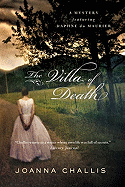
 Third in Challis's series of Daphne Du Maurier Mysteries (Murder on the Cliffs and Peril at Somner House), this is another concoction of nostalgia. The story combines elements of Du Maurier's writing, a dollop of Agatha Christie and a smidgen of the Austens. It all adds up to somewhat less than the sum of those parts. At one point, Daphne says, "If anything happened to him, I didn't know what I'd do. I couldn't live without him." However, despite knowing that neither Christie, Du Maurier nor Austen(s) would have written those words, there is some redemption herein.
Third in Challis's series of Daphne Du Maurier Mysteries (Murder on the Cliffs and Peril at Somner House), this is another concoction of nostalgia. The story combines elements of Du Maurier's writing, a dollop of Agatha Christie and a smidgen of the Austens. It all adds up to somewhat less than the sum of those parts. At one point, Daphne says, "If anything happened to him, I didn't know what I'd do. I couldn't live without him." However, despite knowing that neither Christie, Du Maurier nor Austen(s) would have written those words, there is some redemption herein.
It is summer 1927 when Daphne travels to Thornleigh Manor, ancestral home of her dear friend Ellen, who is finally going to marry her affianced, with whom she has a young daughter. Why they are not yet married and have a child in these post-Victorian times unfolds slowly and contains some of the elements of the mysteries in the story. Everything is blamed on The War, but there is a good deal more to it than that.
The wedding is lovely, and almost everyone is happy for the couple--but shortly after the ceremony, Teddy, the groom, is found dead. Daphne and the dashing Major Browning team up to solve the crime, and that's not all. Major Browning has a faux engagement to Lady Lara (ostensibly because her father is ill unto death and wants to see her married to Browning), which forms a clumsy plot point, and Daphne, who is besotted with the Major, alternately believes and doubts his affections for the Grand Lady.
Suspects are thick on the ground: Ellen; Harry, a youngish old family retainer; and, most spectacularly, Cynthia Grimshaw, Teddy's ex-wife, a shrill harridan who has threatened to sue Ellen for all the money (and there is a lot of it); and her daughter, Rosalie, to whom Teddy has left money and stock--but not enough in Cynthia's eyes. There are also two or three greedy cousins in the picture, giving Daphne and the Major numerous chances to investigate.
Suddenly, Cynthia Grimshaw is found dead from a broken neck at the bottom of a hotel staircase. Did she trip? Was she pushed? As with all mysteries, there are several red herrings tossed about: nefarious business dealings, a sort-of kidnapping and a friend who is not a friend. The snapper at the end is too convenient and not foreshadowed, but it does tie things together. This is definitely not Manderley. --Valerie Ryan
Shelf Talker: Daphne du Maurier as heroine-detective tries to solve the murder of her friend Ellen's groom, while her own romance with Major Browning blooms.

